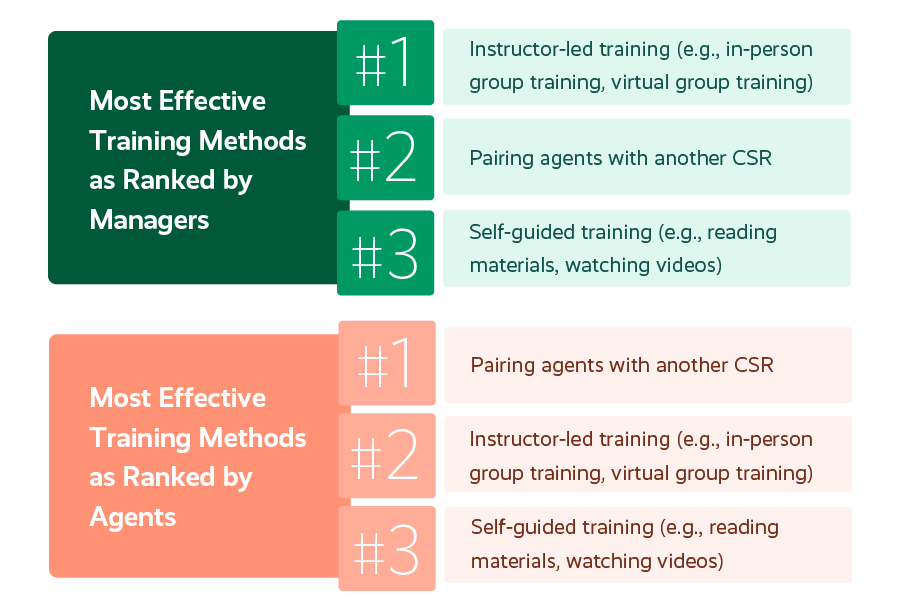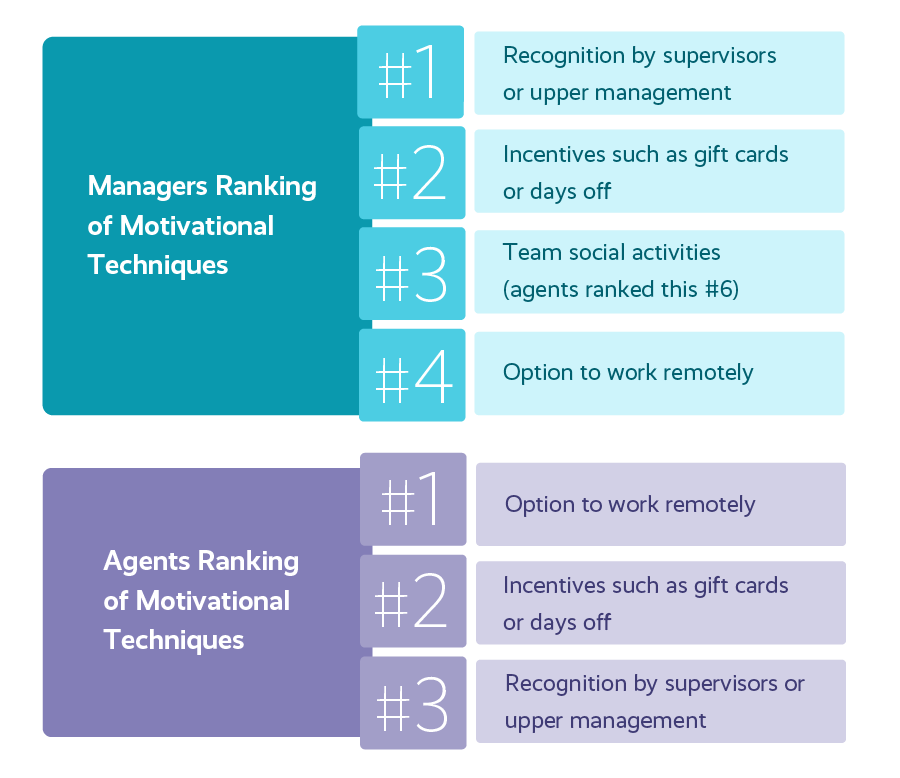3 No-Fail Remote Workforce Training Techniques Top Contact Centers Use
Contact centers succeed or fail on agent performance. Today’s top-performing contact center leaders know remote workforce training and agent engagement are the new imperatives for performance optimization.
Whether your contact center is remote, hybrid, or moving back to the office full-time, getting agent performance right means unlocking the potential of every employee, every day. While most contact centers have successfully transitioned to some form of remote workforce since COVID shutdowns, the return to fully on-site work—and its effect on agents—is unclear. That’s due, in part, to uncertainty fueled by the continued emergence of COVID variants. But there’s more to it.
Recent research by Playvox sheds new light on the state of contact center remote work.

According to the research:
- 60% of contact centers are using a hybrid model
- 40% of contact centers are fully remote
- 68% of agents work remotely 31 to 40 hours per week
- 64% of managers work remotely five or more days per week
- Only 2% of agents work on-site the entire work week
The findings go further to connect the benefits of remote work to agent satisfaction, retention, and recruitment:
- 70% of agents say their job happiness has increased since working remotely
- 50% of agents say they wouldn’t work for a company that didn’t offer a remote work option
- 57% say they would be extremely or very likely to leave their current job if their employer didn’t allow remote work
- 49% of contact center managers are using remote work as a recruitment and retention tool

In its own survey of 700 contact centers, IT research firm Metrigy found the success of remote work has surprised customer experience leaders. Robin Gareiss, CEO and principal analyst at Metrigy, shared with No Jitter that while many industry leaders previously didn’t think remote would work for contact centers, the post-COVID need to effectively (and quickly) pivot has changed their views. In fact, 56% of the Metrigy survey’s respondents said “work from home during the pandemic improved management’s perspective on the viability of remote working,” according to Gareiss.
Related Article: 4 Smart Reasons to Offer Remote Work in Your Contact Center
What is the Future of Contact Center Remote Work?
On the face of it, the research findings are good news for contact centers and their agents. Contact centers have embraced remote work and leveraged the tools, resources, and processes to make it a viable and positive experience for agents.
Agents are happy with the flexible state of work, and managers are using it to drive recruitment. Overall, key metrics such as job satisfaction and retention rates have increased with the flexibility of remote work.
But that’s not the whole story.
As agents increasingly enjoy the flexibility of remote work, they have become less willing to return to work on-site, full-time. Yet, many companies are touting the benefits of working in an office and pushing for a return.
According to the Playvox research, despite the reported successes contact centers are experiencing with remote work, nearly half (45%) of managers surveyed say they’ll bring their agents back to the office in 2022. Another 40% have no plans to return their workforce to an office. It leaves many contact center managers and agents unclear on what’s next for remote, hybrid, and on-site work.
That’s why it’s critical to find proven ways to keep agents happy, efficient, and effective regardless of where they work. And that begins with remote workforce training.
The New Remote Workplace: 3 Proven Remote Workforce Training Techniques
What is a remote workforce today, and how do you continue to build a better one? Training was cited by remote agents surveyed for the research as a key success factor, but it must be well-designed and delivered effectively.
These three remote workforce training techniques—used by top contact centers, including many that participated in the research—quickly shore up lasting agent satisfaction and optimize overall contact center performance.
1. When Training a Remote Workforce, Listen To Agent Preferences
Agents who participated in the Playvox research shared their training preferences, which included varied formats, from self-paced videos followed by instructor-led training to time for independent, simulated, exercise-based training for new software prior to launch.
The research shed light on a disconnect between the remote workforce training techniques managers and remote agents find most effective. For example, managers believe instructor-led training is most effective, while agents prefer to be paired with experienced peers for training.

Top-performing contact centers tune into the training preferences and motivations of their agents. In all work environments, be ready to shift the type of training you traditionally use to better satisfy learning styles and preferences of your current team.
Now may also be the time to reconsider plans to transition back to an office and ensure the effectiveness of remote workforce training. Contact centers that ignore agent preferences for remote work risk spikes in resignation rates. Staying remote means the added benefit of increased efficiency, lower costs, and elevated productivity.
2. Communicate: Keep Asking How to Train, Motivate, and Engage Agents for Best Results
Remote does present challenges. Motivating agents is especially challenging when training and managing a remote workforce. It’s easier to engage teams when they are working together in one place. Birthday, work anniversary, and outstanding performance celebrations, for example, aren’t the same over a video call without the energy of a live gathering.
Top-performing contact centers, though, understand that optimizing training and overall performance requires agent engagement regardless of where teams work. In fact, it’s critical for success.
Yet, many organizations are struggling to get remote engagement right. According to Gartner, 38% of Customer Service Representatives (CSRs) are disengaged from their jobs and 28% are neutral. Disengaged CSRs are 84% more likely to look for a new job than engaged ones. This is significant data because high resignation rates can drive poor customer outcomes and increase operating costs.
The research also indicates 90% of organizations want to drive high employee engagement to help their employees stay motivated and increase retention. That’s because 45% of employees are likely to stay longer at a workplace where they feel engaged and appreciated. And that has a real bottom-line effect: About 21% of companies are more profitable and productive with a highly engaged workforce.
To drive engagement, though, contact center leaders must bridge the gap between what managers and agents say are the most effective motivational techniques. For example, managers believe senior management recognition of performance is most effective, while agents say the option to work remotely is most motivating. This, again, underscores misalignment regarding remote work.

Recognize that motivating agents might require new thinking and different training techniques than you’ve used in the past. Gamification in remote workforce training is one approach. One contact center included in the research uses a remote workforce training program called Kahoot! to create game show-type quizzes everyone can participate in using Zoom.
If you’re struggling to manage your remote workforce, also consider implementing workforce management and/or quality management solutions.
Both managers and agents agree communication is key to helping agents feel like part of a team and improve engagement. Discover how agents are best motivated and engaged through regular, meaningful communication. Daily or weekly one-on-one meetings also can help assess motivation levels and correct issues quickly when necessary. Creative team building is also important, according to agents surveyed.
Related Article: Best Contact Center Games to Play Remotely

3. Be Flexible: Adapt as Needed to Continually Optimize
Perhaps the biggest takeaway from the research is the misalignment between contact center leaders and agents on preferences for and perspectives on remote workforce training and associated motivational and engagement techniques. For top-performing contact centers, though, that data can be a powerful tool for improvement.
The third no-fail strategy for remote workforce management training, motivation, and engagement success is a willingness to adapt techniques as needed. For one, recognize that agents have a strong desire to continue working remotely. This was clear feedback in the research.
To ensure agents thrive and key performance indicators are met, top-performing contact centers are flexible. Not only is now the time to reconsider a transition back to the office, but it’s also an opportunity to consider further changes that will not only stem attrition but improve recruitment.
According to the research, one of the reasons employees love remote work is its flexibility. However, 62% of agents say they can’t choose the shifts they work. Offering even greater flexibility by allowing agents to choose their shifts could differentiate your workplace and attract the highest-caliber employees. Effective remote workforce training is an important way to keep them.
Listen and communicate. Keeping the lines of communication open is important for managers to make well-informed decisions—and take consequential action—which could impact agents’ job satisfaction and have lasting, positive effects on your contact center.
Dig Deeper into the Research on Real Contact Centers
No other component of your contact center has further-reaching effects than agents. Remote workforce training, motivation, and engagement have direct impact on your bottom line.
Learn more from the real-life experiences of contact center managers and agents. Read the complete research findings by downloading Playvox’s new ebook, The State Of Remote Work In The Contact Center Industry.







